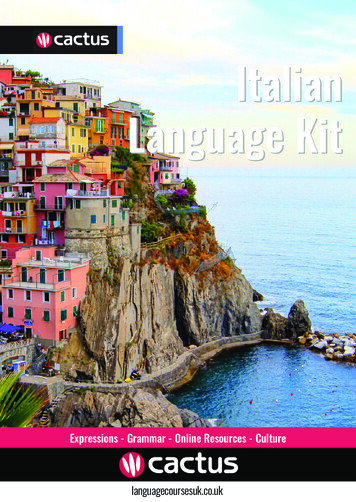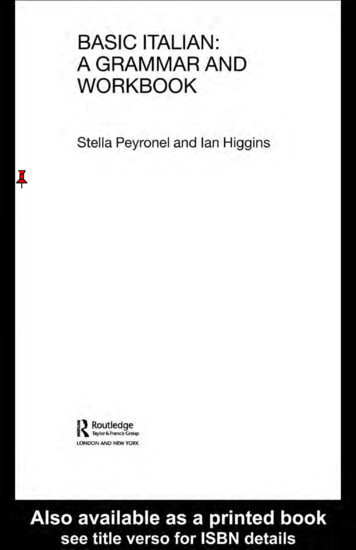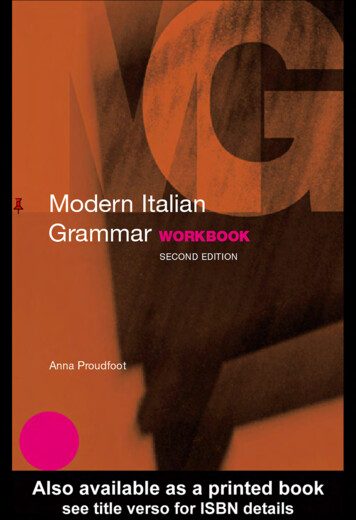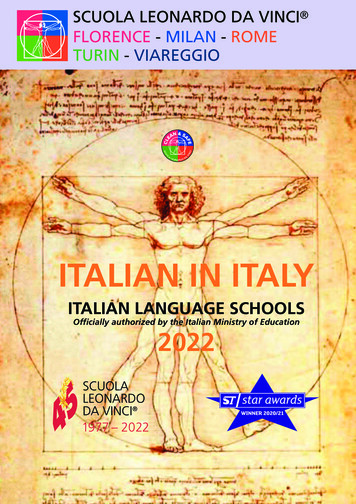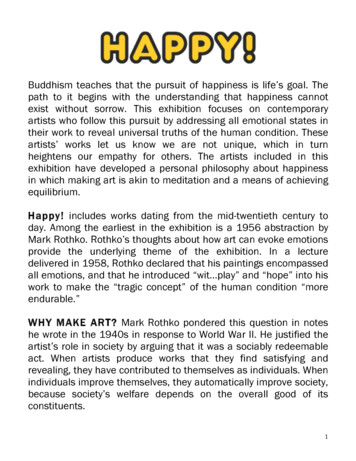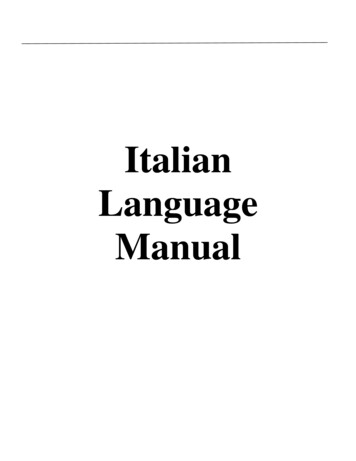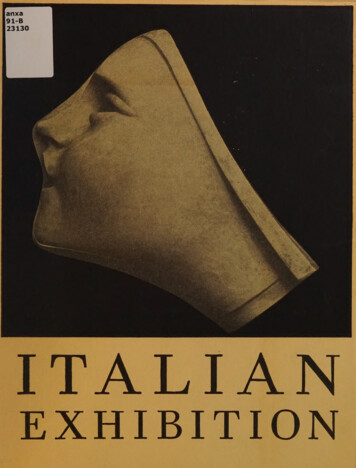
Transcription
OFEXHIBITIONITALIAN EDITALIANMINISTRYBYOF COLASANTIDirector General of Fine Arts, ItalyFOREWORDCHRISTIANAUSPICESBYBRINTONOFTHEITALY AMERICA SOCIETYGRAND CENTRAL ART GALLERIES, NEW YORK1926
CTORY,FROMBY MERICASOCIETYA PHOTOGRAPHWILDTCOMPANY,INC.OF
MEDARDOROSSOEcce Puer
Lent by the Brooklyn MuseumGIOVANNIBOLDINIPortrait of Whistler
NOTEON THEEXHIBITION[ 1s with the greatest pleasure that the Italy America Society presents andcommends to the American public the first exhibition of Modern ItalianArt which the Italian Governmenthas, on our invitation, assembledandsent to this country. In art Italy carries not only the glory but the weight ofa past so extraordinary that it is indeed difficult for a contemporary artistcoming from Florence, Rome, or Venice to overcome the handicap of thenames of his countrymen which echo in schools and museums throughoutthe world. Italy offers the student of art so great a task, and such an abundance of material from the past, that we are easily led to disregard theachievements of the present day. The exhibition organized by the ItalianMinistry of Public Instruction, of works chosen under the personal supervision of one of Europe’s foremost art critics, Arduino Colasanti, Director ofthe Department of Fine Arts, tells us that united Italy is second to no greatnation in number of artists, and in sincerity of artistic expression, the influence of which has been widely felt beyond the narrow borders of thecountry itself. The Italy America Society is deeply grateful to His Majesty,the King of Italy, who granted the exhibition the honour of his patronage; toHis Excellency, the Italian Ambassador, and to His Excellency, HonorableBenito Mussolini, for the generous support of the Government; to the Ministry of Public Instruction, and particularly to the Department of Fine Arts,which assembled the collection. The work of the Italy America Society inpresenting the exhibition in the United States has been made possiblethrough the co-operation of the Grand Central Art Galleries, New York;the Museum of Fine Arts, Boston; the National Gallery of Art, Washington;the Art Institute of Chicago, and the California Palace of the Legion ofHonour in San Francisco. To Dr. Christian Brinton the Society expressessincere thanks for his valued assistance in the preparation of the notablecatalogue, and to the Brooklyn Museum for the loan of the portrait ofWhistler by Boldini. The officers of the Society are particularly indebtedto Dr. Lauro de Bosis and to Mr. Abram Poole who first conceived the ideaof organizing the exhibition, which was consummated by the active work ofthe Committee on Arts and Letters, of which Mr. Otto H. Kahn is Chair-man, and by the united support of the Society.Tuomas W. LAmont,President of the Italy America Society.
ANTONIOMANCINIAzaleas
FOREWORDBy CuristiAN BRINTONINCE aesthetic reciprocity is fast becoming a distinctive feature of international amity, it is with grateful appreciation that we welcome theartistic achievements of our friends from overseas,and from time totime are moved to respond in kind. Post war exhibitions of foreign art inAmerica have thus far included more or less representative displays fromEngland, France, Sweden, Holland, Switzerland, and Russia. Italy, theveritable cradle of modern art, and creator of the modern social order has not,however, appeared officially in our midst since the Panama-Pacific Expositionat San Francisco in 1915. Generally speaking, we do not know what changeshave been wrought in the spirit and character of Italian artistic productionsince the shock and stress of war and the heroic period of recuperation. Itthus remains for the present exhibition to reveal Italy of to-day as seenthrough the eye of the creative artist.The Italy that comes to us flushed with new-found glory is the sameItaly over which has for ages brooded the spell of antique beauty. There hassimply occurred during these last brief years another Rinascimento, a NewRenaissance, which but throws into sharper relief certain fundamentallyItalian characteristics. Nurtured upon a pregnant past, and reachingvaliantly toward fresh conquests, the rhythm of Italy is more clearly definedthan is the evolutionary curve of other countries. The various modernartistic movements from the Divisionism of Segantini and Previati to theDynamism of the Futurists each possesses a plastic appeal typical of a racenoted for vivid expressional eloquence. It is in fact this same faculty forplastic expression that constitutes the keynote of contemporary Italian art.The aim of the present exhibition is to offer a balanced and comprehensivepicture of current Italian artistic activity. The picture opens with the workof the great protagonists, Boldini, Mancini, and Medardo Rosso, and closeswith a courageous presentation of Futurist painting and decorative art.Every movement of consequence finds place on these walls, with special
emphasis upon the work of certain painters and sculptors who have risen toprominence as the result of post war influences. You will hence be able toadjudge the merits of what may be termed the living art of Italy. You willbe able to trace in line, colour, and form the artistic physiognomy of a countryrecently fired to new effort yet ever mindful of its heroic heritage.The first feature that is apt to strike the sympathetic observer uponviewing the collection as an ensemble is its sturdy independence of inspiration, its aesthetic autonomy. During periods when most of the world wasstriving by turns to be Impressionist or post-Impressionist, Cezannist orCubist, the Italians were working along lines at once individualistic andnationalistic. That species of artistic Francomania which flourished fromStockholm to Barcelona and from Manhattan to Moscow did not take seriousroot in the soil of Italy. The Divisionist technique which Giovanni Segantinievoked in anguish and exaltation amid the clear heights of the Engadine,instead of destroying, placed vigorous stress upon mass and contour. Andsimilarly the sculptor Medardo Rosso declined to succumb to the spell ofRodin. He actually exerted considerable influence upon the master ofMeudon in the matter of leading him from smooth pseudo-classicism towarda freer handling of surface and that subtle interplay of light and shade uponfixed surface which is the very soul of sculpture. The same is true of theFuturists who, led by their intrepid fugelman, Marinetti, turned Cubism,which was static, into something not alone dynamic, but kinetic. In eachcase these men proved themselves initiators not imitators, and as such addedfresh vitality to the larger volume of their country’s artistic aspiration.The most copiously represented of the older group of contributingpainters, and the one whose work will probably attract the major measureof attention, is the fertile Mancini, who has been a figure of internationalimportance for some decades. Mancini no longer inhabits his picturesquestudio in the Via Margutta, the artists’ quarter of Rome. He has recentlymoved to more commodious lodgings. It was a pleasure to find that he hadprospered, but even more so to realize that, despite his fourscore years andabove, he was still painting with his old-time zest and dexterity. It is an artthat appeals to eye rather than mind, that belongs to the realm of material
objects rather than the questing reaches of the imagination. Yet, whatpainter has extracted so much joy out of sheer masses of pigment, suchsensuous delight from the gleaming surfaces of simple, actual things—abouquet of flowers, the glint of silk, the glance of an eye, the flash of a fan.A wizard of equal witchery is Boldini, though what Mancini achieveswith the free manipulation of mass, Boldini attains through the nervous playof line and movement.Painting with Manciniremains,however,manner.With Boldini it rises to the pitch of genuine style, something akin to theswagger baroque of Bernini. Whatever the distance that divides the two,they stand the undisputed masters of contemporary Italian) portraiture,Mancini with a sprightly charm that recalls Naples, where he studied,Boldini with a cosmopolitanism acquired during fifty years’ residence of Paris.Upon paying appropriate respects to the work of Michetti, Sartorio, andthe men of the succeeding period such as the sensitive feminist, Innocenti,one may proceed to a consideration of certain younger talents. Among thesemaybe cited Spadini,Casorati,Oppi, Ferrazzi, De Chirico, Conti, andDonghi. While Spadini’s lustrous colouristic vision was almost exclusivelydedicated to scenes from domestic life, the work of his colleagues marks theadvent of that New Classicism so popular in present-day Italy. Somethingof the spirit of bygone Hellas seems to have been wafted across to the landof cypress and sun, for these painters one and all worship purity of form andclarity of contour. Casorati and Oppi are the most convinced and consistentof the group, yet each is in some measure impelled by a well defined impulseto renounce the accidental and superficial, and reflect the reasoned unity ofsober colouration and essentially integral volume. It is these artists who havebeen carrying off most of the honours at the Biennial Exhibitions in Veniceand Rome, and whose influence is paramount in the field of pure painting.The reversion to formal tradition, and the appeal of intellect rather thancreative instinct which characterizes the attitude of the foregoing men, findsits antithesis in the production of the Futurists, whose work is astir withdynamic impetus. Balla, Depero, Prampolini, and their associates attackvirtually every phase of aesthetic endeavour, and to each add their quota ofthat vital, daring Marinettismo which animates them all. There are those
who maintain with touching elation that Cubism is dead, but whether or notthis be so the same cannot be charged of Futurism. Possessing an activeemotional content,and an unfailing mental flexibility, the Futurists haveyear after year scored fresh triumphs in various fields.Standing apart from his fellow painters in self-imposed isolation is thefigure of Modigliani, who drifted to Paris to win, almost at the same moment,triumph and a tragic end. A modernist in the vein of Derain and Picasso, henevertheless harks back to his native land, to the remote allure of Tuscanprimitive—to a mystic, sensuous appeal without time or date. And just asModigliani is a unique apparition in the province of painting, so is theMilanese, Adolfo Wildt, a kindred phenomenon in contemporary Italiansculpture. Unequal though it be, the production of Wildt is touched by apsychic evocation, a power of symbolic expressionism, that place him in acategory by himself. He seems the one Latin artist who has, so to speak,broken the classic mould—who has felt the breath of Northern mystery.The balance of the sculpture, including the sincere fusion of classic tradi-tion and modern sentiment which typifies the vision of Antonio Maraini,together with the display of black and white and of applied art, completeour brief survey of the exhibition. In all this work you will have discerned adistinct regard for form as such, a marked degree of pure plasticity of inspiration. These walls do not glow with the chromatic fantasy to which ourSlavic friends have accustomed us for, save the Futurists, the Italians arenot vivid, luminous colourists. In compensation, however, this art evinces anassured measure of structural integrity. Strength of design it also possesses,and likewise unity of purpose. It indeed everywhere displays the purposefulunity of an aspiring and homogeneous people.As the artistic expression of a country whose past is of transcendentglory, the current exhibition would in any event command attention. Yetthis is not all, for the soul of Italy has not been strangled, but strengthenedfor fresh effort by the legacy of formal beauty. That art is playing itsappointed part in the present Risorgimento there are numerous indications.Already from the fluted throat of Wildt’s valkyr one seems to hear the clearcall to a still higher national destiny.
CATALOGUE
PAINTINGBALLA,GracomoBorn in Turin, 1874. Studied painting alone and won recognition at an early age. Hehas constantly searched for new technical methods and has worked independently ofany school, alike indifferent to criticism or appreciation. He attempts to interpretmovement in colour and form. Lives in Rome and is a prominent member of theFuturist group.1 Forest Motivation2 Sensation of Spring3 IdeaBOLDINI,GtovanntrBorn in Ferrara, 1854. Studied painting at first under his father, then at the Academyin Florence. He obtained his first professional success in London. In 1872 he went toParis where he has lived ever since and obtained world renown as a portraitist. Hiswater colours are as much admired as are his works in oil, and besides portraits he hasbeen successful in composition and landscape. Represented in the Gallery of ModernArt in Rome, the Brooklyn Museum, and numerous important public and privatecollections.4 Portrait of WhistlerLent by the Brooklyn Museum5 Portrait of Mrs. Rita de Acosta LydigLent by Mrs. Lydig6 After the BallCADORIN,GurpoBorn in Venice of a family of artists, he attained recognition at the age of nineteen byhis paintings exhibited in the Gallery of Modern Art, Rome. The King of Italyacquired his Cigarette Makers which was exhibited at the Venice Biennial in 1920.He has recently been dedicating himself to applied art, rediscovering a number of
ancient technical processes. He has produced metal plates, lacquer furniture, printedsilks and canvases. His genius as a decorator has found its most complete expressionin the restoration of the Papadopoli Villa near Vittorio Veneto.7891011ModelSquare in VeniceCanal in VeniceFishing with HarpoonSpring on the LagoonCASORATI,FELICEBorn in Novara, 1885. At present lives in Verona. Studied law, music and literature and finally turned to painting under the guidance of Vianelli at Naples. His firstpaintings were accepted at the Biennial Exhibition at Venice in 1907, the same year inwhich he obtained his Doctorate in Law at the University of Padua. Casorati deliberately omits detail, in attempting an almost abstract search for the essential forms ofthings.1213141516Portrait of Signor Riccardo GualinoPortrait of Signora Riccardo GualinoPortrait of Signor BeriaPashaMiddayCONTI,PrimoThis young Florentine on the occasion of his special exhibition in Rome in connexionwith the third Biennial had the good fortune to provoke heated controversy amongthe critics, some of whom lauded him as a dawning prodigy while others saw in him animitator of Tito. He is certainly one of the most interesting figures in contemporaryItalian art. The free composition of his Rape of the Sabines and his Golgotha are instrong contrast to the sobriety of his Mother in the Red Blouse, and his portraits ofChinese characters.17 Liung-YukLent by the Gallery of Modern Art, Florence18 ChineseDECHIRICO,GtorctoBorn in Greece, 1888, of Italian parents. Has studied and lives in Rome. Hisoriginal style created great interest in France, Belgium, and Italy where he has participated in a number of exhibitions. His art has been described as having a meta-
physical character. With an original and extremely modern technique he seems tohave felt the influence of the Italian masters of the fourteenth century. Among hisworks are Hector and Andromaca, The Trovatore, The Troublesome Muses.19 Portrait of the Artist20 Portrait of the Artist’s MotherDEPERO,ForrunatoBorn in Rovereto, Venetia. Lives in Rome. Depero is one of the most prominent artistsbelonging to the Futurist movement. He has been an exhibitor in national as well asinternational exhibitions and created numerous controversial discussions. Like allFuturists he has been especially successful in decorative and applied art. His clevertoys, stage decorations, tapestries,and furniture created a sensation at the Exhibitionof Decorative Arts in Paris, 1925.21 Wild Horses22 Train at Dawn23 Woman EmbroideringDONGHI,AnrontoBorn in Rome, 1897, where he pursued his studies at the Institute of Fine Arts.After fighting as a soldier in the World War he devoted himself while at Florence andVenice to a painstaking study of the art of the seventeenth and eighteenth centuries.He won his first notable success at an exhibition held in the Bragaglia Gallery in Rome.Lives and paints in his native city.24 The Artist25262728BridgeBaroque ChurchStreetThe Stairway2930313233The Table is SetAt the InnThe Fortune TellerNudeWasherwomenFERRAZZI,FEerRrucctoBorn in Rome, 1891. He copied old masters for a time under the guidance of hisfather and then studied under Coromaldi and Sartorio at the Institute of Fine Arts inRome. Devoted at first to Segantini, he then passed a short but interesting interval in
the Impressionist movement from which he reverted to the masters of the fifteenthcentury. Now at thirty-four he has developed a highly original art not without tracesof the varied influences of his early years. In sculpture also he has attained considerable distinction.343936on3839AQ)Al42The IdolThe StormValley of TivoliAniene River at TivoliThe Tragic JourneyHoritia and ChildAdolescence (Study)Family of the ArtistStudy for the AboveINNOCENTI,CamitioBorn in Rome, 1871. At first a student of classical literature, he became interested inart after working as a model for Ludovico Seitz. During subsequent travels in Spain hedeveloped a passion for Velazquez, but eventually turned from this master to devotehimself to pointillism. After 1911 his work became frankly impressionistic with aninsistence upon the picturesque somewhat reminiscent of his early Spanish experience.43 Andalusian WomanAA The Black VeilAD SummerMANCINI,ANTONIOBorn in Albano, near Rome, in 1852. He owes much to Naples where he studied underDomenico Morelli and where he won his first success in 1877 with a canvas entitledLove Thy Neighbour as Thyself. Mancini is a realist but his realism is pervaded by aninvincible cheerfulness and good humour. With the years his work acquired a certaincomplexity of detail which has induced some critics to prefer his earlier productions.Public galleries in Rome, Munich, Amsterdam,York contain masterpieces by this artist.46ATAS49DesiresPeasant GirlIn the GardenVenetian WomanDublin, Florence, Boston, and New
30olo2d3o4Sys)56a7AzaleasThe ScarfFlagsGirl with MandolaLandscapePortrait of the ArtistBanditSpringMICHETTI,Francesco PaotoBorn in Tocco Casauria, Abbruzzi, in 1851. He studied painting under Morelli inNaples, returning thereafter to the solitude of his native village. At the NeapolitanExhibition in 1877 his Corpus Domini, depicting a popular religious ceremony of theAbbruzzi, brought him suddenly into fame. He is commonly regarded as a counterpartin painting of his great friend d’Annunzio for whose tragedy entitled The Daughter ofJorio, he made a painting of the same name, acquired by the German Kaiser, which isconsidered his masterpiece. He is now a senator and lives in an old convent at Francavilla al Mare, in the Abbruzzi.28396061Golden CloudsHead of PeasantLandscapeSheep and Goats62 In the Grass63 On the Beach64 Abbruzzi Landscape65 Peasant WomanMODIGLIANI,AmEpDEOBorn in Livorno in 1884. After graduation from a classical high school he applied himself entirely to painting, first at Livorno under Micheli, then at the Florence Academyof Fine Arts. He made brief sojourns in Rome and Venice and thence went to Pariswhere he lived the rest of his brief life as a member of the group called La JeuneFrance. For a time he followed the French Cubists but soon evolved a manner quitehis own which has something of the feeling of the Italian Primitives. He died in Parisin 1920.66 Portrait of M. BaranowskiLent by H. Bing § Cie
67 Madame ModiglianiLent by H. Bing g Cie68 BlondeLent by H. Bing § Cie69 NudeLent by H. Bing § Cie70 Young WomanLent by Mr. Paul Reinhardt71 PortraitLent by the New GalleryNOCI,ArturoBorn in Rome where he studied painting at the Royal Institute of Fine Arts. Hefollowed for a while the Divisionist movement and developed an independent technique,devoting himself both to landscape and portraiture. He is the winner of several competitions and has partaken in numerous national as well as international exhibitions.Two of his paintings have been bought by the National Gallery of Modern Art inRome. Noci is at present a resident of New York where he is chiefly known asa portrait painter.72 Venetian Fisherman73PortraitOPPI, Usa.poHe was born in Bologna where he at present lives. Considered as one of the mostpromising among the younger artists, he awakened great interest at the latest BiennialExhibitions both in Venice and in Rome. One of his pictures was awarded the GoldMedal at the last Carnegie Institute Exhibition in Pittsburgh. He is a realist, buthis realism is distinguished by classic severity and accuracy of detail.74 Fishermen at Santo Spirito75 Breton GirlPRAMPOLINI,EnricoWith Balla and Depero, he completes the Futurist triumvirate. While he was born inMilan he is a resident of Rome, and was one of the first to follow the movement headedby Marinetti and Boccioni. He has been particularly successful in the decorative arts,having been awarded the Grand Prix and three Silver Medals at the Exposition ofDecorative Arts in Paris, 1925.76 Jazz BandEditor of the Futurist Review.
TE ouvetities Architecture78 Portrait of the Artist79 CapriROMAGNOLI,GtovanniBorn in Faenza, 1893. Studied fine arts at the Institute of Bologna under DomenicoFerri and Augusto Majani. He made his debut at the Promotrice of Bologna and theSecession of Rome. Since then he has regularly taken part in all the Italian exhibitionsof national importance. His latest work reveals considerable advance both in emotional content and in technique. His Ballerina is on permanent view at the Gallery ofModern Art in Rome.80 Cherries81 Nude82 Pomegranates83. DianaSARTORIO,Grutto ARISTIDEBorn in Rome, February 11, 1860, he came from a family of poor artists and receivedhis first instruction from his father who was a sculptor. At the age of seventeen he wasmaking his living as a designer. He had the good fortune to enlist the interest of NinoCosta, Giuseppe Raggio, and Michetti, who saw in him the promise of a great artist.He spent two years in England and finally settled in Rome where he has attained greatfame in landscape, composition, and decorative painting. A master of pastel, theRoman Campagna found in him an illustrator of classic accuracy. He is the authorof the monumental frieze in the Italian House of Parliament.848586878889909192Portrait of a Girl in the OpenMalariaPonte MilvioAlpine PostoWindmill at TerracinaThe Pines at FregeneAlong the ShorePine TreesFuneral on the Adamello
SIRONI,MartoBorn in Sassari, Sardinia, 1885, Sironi is a Roman by training and experience, and oflate a resident of Milan. Belongs to the Twentieth Century Group which commandedconsiderable attention at the recent exhibition in Venice. He is a synthetic artist, butan Italian synthetist, enamoured of the seventeenth century. Well known also as acaricaturist, he regularly draws for Mussolini’s paper, Il Popolo d’Italia.93 The ArchitectSPADINI,ArnmMAnpboBorn in Florence, 1883. A self-made artist he began with the decoration of pottery,an activity to which critics have attributed the luminosity and lustrous glazes whichcharacterize many of his canvases. He won a most spectacular and sensational successat the Venice Biennial in 1924 which brought him to the forefront among contemporaryItalian artists. He died in Rome, 1925, in the full flower of his art.949596979899100101102103104105106107108The KissThe VisitationThe Toilette of VenusAsleepWife of the ArtistAnna in WhiteStudy HourThe Marriage of St. CatherineMother and ChildCat and KittensBoy with LobsterChildren with FruitLandscapeParkVilla Borghese
SCULPTUREANDREOTTI,LiseroBorn in Pescia, Abbruzzi, Andreotti was successively blacksmith, bookstore clerk, andcaricaturist before turning to sculpture where he has won renown. He studied modellingfirst in Florence, then in Paris, where he remained until 1914. For a time under theinfluence of Bourdelle, he now finds his principal inspiration in the Tuscan art of theRenaissance, especially in Jacopo della Quercia. His Italian Mother will soon be unveiled in the Santa Croce in Florence, where he occupies the chair of sculpture at theInstitute of Decorative Art.109 Girl with Cherries110 BatherDAZZI,ArturoBorn in Carrara, January 13, 1881. Dazzi’s work reflects the spirit of his marble-ribbedAlps. He has given Italy two famous war monuments, one to the hero Enrico Toti,and one to the railwaymen who died at the front. One of his statues has found its wayacross the Atlantic to Lima, Peru. He contributed the reliefs to the Banca d’Italiabuilding in Rome, and to the Triumphal Arch in Genoa.111 Antonellaies Calt113 Nymph114 American Girl115 SpringGEMITO,VincenzoBorn in Naples, May 11, 1852. He studied under Lista and Caggiano, and in 1867obtained a sensational success with his Fisher Boy which was acquired by Meissonierand has now found a permanent home at the Bargello in Florence. Moving to Paris hebecame one of the most popular artists of the French capital and filled many orders forbusts, portraits, and statuettes. Famous are his Water Boy, The Spring, and Neptune.
He had a strong sense of the lure of the sea which he preferred to envisage underreconstructions of a mythical seafaring universe. His energetic career was hamperedby an attack of insanity which, though subsequently cured, left him without theoriginal fullness of his powers.116 The Philosopher117 ChildGERARDI,ALBERTOA Roman by birth. For a long time principal of the Artigianelli Institute on theAventine. He is now a teacher in the School of Applied Arts in the Viale Manzoni inRome. Gerardi is a sculptor of distinction but he owes his fame to his work in ironwhich was first exhibited in the Biennial in Rome and later at the Pesaro Gallery inMilan. Some of his chalices and pieces of Franciscan inspiration may be seen at thePermanent Exhibition of Christian Art in Venice. Certain of his best things were executed at the request of d’Annunzio. Of late he has turned to portraiture in ironand bronze.118 Portrait of a Man119 The Artist’s DaughterMARAINI,ANnrTontoBorn in Rome, 1881. He has enjoyed a classical training and taken his degree in law.Has written extensively as a critic. He executed his first works under the encouragement of the painter Bargellini in whose studio he modelled a statuette called Perseuswhich was awarded a silver medal at Brussels. His most famous work is the Via Cruciserected in a church on the Island of Rhodes. His bas reliefs exhibited at the recentBiennial in Venice attracted wide and favourable attention.The KissVisitorsBathingEvePRINI,GiovanniBorn in 1877 at Genoa, where he studied sculpture at the Ligurian Academy of FineArts. Made his debut with his Brides of Liguria at an exhibition in Turin in 1890.For many years he has lived in Rome. His Portrait of a Woman has been acquired by
the Gallery of Modern Art in Rome. His many statues, mortuary monuments andvotive chapels reveal broad human sympathies and express a mood of melancholyresignation. Displays great talent in his combination of sculpture with architecturalmotives.124 The Family IdolROSSO,MeparpoBorn in Turin, June 20, 1858. Was at first interested in painting which he studiedwithout a teacher. To this early experience are attributed certain characteristics of hislater masterpieces. Until the time of the post-Impressionistic and synthetic reactionRosso exerted a great influence in Europe. French critics credit him with havingweaned Rodin away from Renaissance smoothness as well as from excessive fondnessfor displaying physical strenuousness.125126127128ChildEcce PuerReadingThe ServantSELVA,ATrTritioBorn in Trieste, 1883, where he studied at the Industrial School. In 1907 he won theRoman Fine Arts Prize and has since been living in the capital with his family. Hiswife has been his favourite model. He leapt into-prominence first at the Secession andlater through a private exhibition held in Rome. Three of his works: The Sabine Girl,The Riddle, and The Idol, have been acquired by the Gallery of Modern Art in Rome.He is also distinguished in dWILDT,AbotroBorn in Milan in 1868. Wildt’s work has provoked vivacious and contradictory discussions. A sculptor of vast experience, he has developed extraordinary fluency asa stylist and a virtuoso not without great variety of mood. Perhaps the perplexity
which his art arouses is due to the fact that he is thought of not as a primitive butrather as baroque. His predilection for deep incisions and low reliefs, his expressionism,in short, tends to support these conclusions. At first regarded as a realist he is nowclassed among the symbolists. Among his outstanding works are his Trilogy, TheFuneral Monument of the Boschi Family, his Mask of Grief, and his Conception.133134135136137138139140Portrait of the ArtistHis Excellency Benito MussoliniMariaThe IdiotThe nioBorn in Mantua, June 3, 1893, now a resident of Rome. Studied engraving in Veniceunder Ettore Tito and subsequently in Rome under Aristide Sartorio. Noted especially for engravings, often with a humorous touch illustrating modern life in Rome—Campo de’Fiori, Island of San’ Bartolomeo, etc. More recently he has shown theinfluence of Paris, particularly of Meryon, in his prints. Two albums of
Post war exhibitions of foreign art in America have thus far included more or less representative displays from England, France, Sweden, Holland, Switzerland, and Russia. Italy, the veritable cradle of modern art, and creator of the modern social order has not, however, appeared officially in our midst since the Panama-Pacific Exposition .
